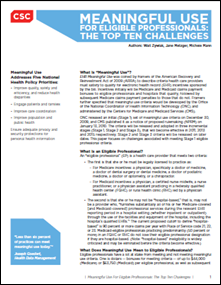We asked several EMR and consulting executives the following question:
What will be the effect of the HITECH Act in terms of short- and long-term EHR innovation?
Victor Arnold, Managing Partner, AsquaredM

What I am hearing from clients is that they are just doing their best to get an EHR up and going, let alone worry about innovation. That means to me the impact is going to be long term — once people figure out what they have, what it *really* does, and then, what they need to do. This will probably take a couple of years to settle in, by my estimate.
Clinical processes are extremely variable, even within a given institution. And the “need to do” is going to be a problem for everyone. I am sensing that people are just now realizing how “one-off” their clinical processes are internally and what a monumental job they are going to have in figuring out, and then deriving, a “common” clinical work flow.
This is the next great hurdle for the EHR. Once they get past congratulating themselves for implementation (clients) and sales (vendors), then they have to make is sustainable. That means some level of standardization. That will drive the innovation.
A counter force that will dampen innovation will be the mainline vendors. This is not to say they aren’t willing to be innovative, but rather they will be in a “guns or butter” situation with R&D versus support budgets, once they get their sales to the point of revenue recognition. This may leave room for an agile vendor that is capable of rapid development to grab a place, or more likely, innovation will come from third party firms that cover the space between vendors and clients and can offer services to clients that address needs that vendors are able to handle. This has been common in the HIT space for years and will probably be in play again.
Rob Culbert, President, Culbert Health

In the short term, EHR vendors will focus on two primary activities: developing functionality to support Meaningful Use and client implementations. The reality is that resource constraints will hinder innovation over the short term.
In the long term EHR vendors will benefit from having product developers heavily involved in the implementation process and will have a much better understanding of clients needs to drive future development.
As more practices achieve MU, best practices and advanced informatics capabilities will drive a new wave of transformative innovation focused on clinical quality and outcomes management.
Girish Kumar Navani, CEO, eClinicalWorks

The HITECH Act will probably have a bigger impact on adoption than innovation. We believe that companies will, and should, continue to listen to their customers and build their products accordingly, so with or without the HITECH Act, companies will continue to innovate and make their products more affordable and easier to use.
Tee Green, President, Greenway Medical Technologies

As electronic health record software providers, we have always used our research and development capabilities, both in terms of funding and priority, to drive innovation. And I feel I’m speaking for most of the industry here as well. It’s a matter of seeking the competitive edge and of course advancing healthcare outcomes.
I believe that in union with public health agencies and federal standards boards we have led innovation and paid attention to standards to the point that innovation has made the goals of the HITECH Act realistic for individual care providers and for the creation of a national health information network.
Within the current and anticipated CMS and ONC proposals as well as deadlines and timetables it’s important to remember that the HITECH Act is a foundation for an unlimited potential. In terms of future innovations either short- or long-term, as the HITECH Act provisions take hold, the research and development Greenway is undertaking will continue to utilize customer communication avenues to collaborate on advancements in interoperability, usability, and reporting methods, all to improve point-of-care efficiencies and patient safety. That’s where we see the overriding points of continued innovation.
Greenway’s integrated platform for clinical, financial, and administrative workflows is designed as an innovative foundation allowing for rapid customization of customer and industry requirements. From that foundation comes the ability to add data points and expansion. Within our PrimeSuite EHR comes PrimeResearch, which advances clinical trials and research and therefore better medicine. Innovations in genetics and mobility and revenue cycle management are also being realized in the short term.
I think the greatest long-term innovation is going to come from within the sensibilities and experiences of care providers. As we drive more and more important data capabilities to them, providers will want more, and together that will fuel collaborative and innovative thinking. It’s a dynamic we’ve realized since our founding by practicing physicians, and I know that the HITECH Act is providing unlimited horizons for innovative leadership.
Hayes Management Consulting, Peter J. Butler, President

The HITECH Act will have a positive impact on EHR innovation in both the short and long term. Providing financial incentives to implement EHRs will speed up EHR adoption. In order to stay competitive in the marketplace, EHR vendors will need to provide innovation solutions and product offerings now that can achieve meaningful use.
With new projects like the Strategic Health IT Advanced Research Projects (SHARP) Program, funded through the HITECH Act, organizations including Harvard and the Mayo Clinic will receive $60 million in cooperative agreements to perform advanced research in healthcare information technology. Projects under SHARP will help address some of the barriers facing organizations when implementing EHRs and will foster data sharing and collaboration which are essential components to improving healthcare.
Jay R. Anders, MD, CMIO, MED3OOO, Inc.

This is a very interesting question. The HITECH act has a lot of vendors scrambling to both monitor regulations as well as develop functionality that will be needed to certify under Meaningful Use.
In the short term, EHRs will have to adapt quickly to an ever increasing bar proposed by the Meaningful Use regulations. Some vendors will not survive this rapid transition. Innovation functionality will be limited to meeting regulatory requirements and will focus will be placed on truly long range innovation.
In the long term however, focus will shift from meeting regulatory requirements to actually creating products that physicians can use to not only reduce their workload but augment the quality of medicine. Advances in physician decision support and evidence based population health management will start to appear. Also, technology advance in speech recognition and parsing medical text into codable data will mature to the point of being useful.
So the bottom line is: short term, get it installed and paid for. Long term, make it something physicians can really use.
Scott Decker, President, NextGen Healthcare

In the short term, all EHR vendors have to make adjustments to their products to ensure they meet the criteria for meaningful use (MU) – it’s the degree of change required that varies across vendors.
Providers should take note of the amount of work their prospective EHR partners still have to do before choosing one to help them demonstrate MU. NextGen Healthcare has already been helping customers with efforts to achieve MU on time and I am confident the feature sets and flexibility of our software will be able to meet the standards. NextGen EHR version 5.6 is already a CCHIT Certified 2011 Ambulatory EHR and our ePrescribing product holds the highest level of certification available. We have also already demonstrated exchange of data as described in the criteria.
Over time, more regulations will arise and further innovation will inevitably be required of all EHR vendors. Those that are continually innovating though, outside of the latest incentives, will have a head start and be able to start helping clients early. For example, to augment our existing Healthcare Information Exchange product, we developed HIE Connect, so that providers can plug their NextGen EHR into any established HIE and share patient data in real time. At the same time, our NextGen Patient Portal already enables interactive care between the patient and his or her doctor, helping to meet several of the patient access and information exchange criteria for meaningful use.
Betty Otter-Nickerson , President, Sage Healthcare

HITECH is driving physician interest and slowly beginning to drive adoption rates of EHR products, which will in turn make additional investment in those products possible. HITECH also places emphasis on how physicians use EHR.
Our industry’s challenge will be to continue innovating its products so that they become easier for customers to use and less obtrusive to implement, while providing services that make for a seamless integration of information technology into the patient care process. Providing a seamless transition for customers is our primary focus, and should, I expect, eventually, drive any remaining hold-outs toward adopting an EHR.
However, in the short term, HITECH may improve the effects of CCHIT, which historically seem to have stifled innovation to some extent. CCHIT certification has required building features and function for which there is not necessarily a demand in every case, but, nevertheless, must be built to "pass the test". Also, certification has leveled the playing field to a certain extent since all vendors must offer a number of the same core features.
HITECH should provide opportunity to drive technological innovation as vendors continue setting themselves apart from the competition and add value for improving patient care. Innovation requires investment and resources, which we’re continuing to apply even as we maintain our CCHIT certification, and look toward supporting Meaningful Use.
Evan Steele, CEO, SRSoft

The answer depends on how you define innovation. If you define it as finding new and better ways to help the end-user (i.e., the physician), there is no question that meeting the demands of HITECH will sap innovation in the EMR industry for a long time. As vendors chase increasingly stringent—and ever-changing—government criteria, they will have few resources left to enhance their products in ways that address what physicians want, and really need.
Under the HITECH Act, the government defines what sort of innovation is needed. There will certainly be innovation by EMR vendors as each tries to find a way to align its software with the HITECH criteria.
However, this type of innovation, which is not accompanied by improvements in workflow and productivity, does not help physicians in their daily delivery of patient care. Unfortunately, finding innovative ways to meet these criteria will consume the lion’s share of vendors’ development time and resources, with little or none left over for the innovation that is sorely needed — innovation that would transform failure-prone EMRs that obstruct doctors into user-friendly ones that actually help them.
Physicians are clamoring for products that are easy to use and increase their productivity, letting them provide better care to more patients for higher total revenue in the face of growing demand and declining reimbursement rates. Coming up with those products will require real innovation.























The article about Pediatric Associates in CA has a nugget with a potentially outsized impact: the implication that VFC vaccines…